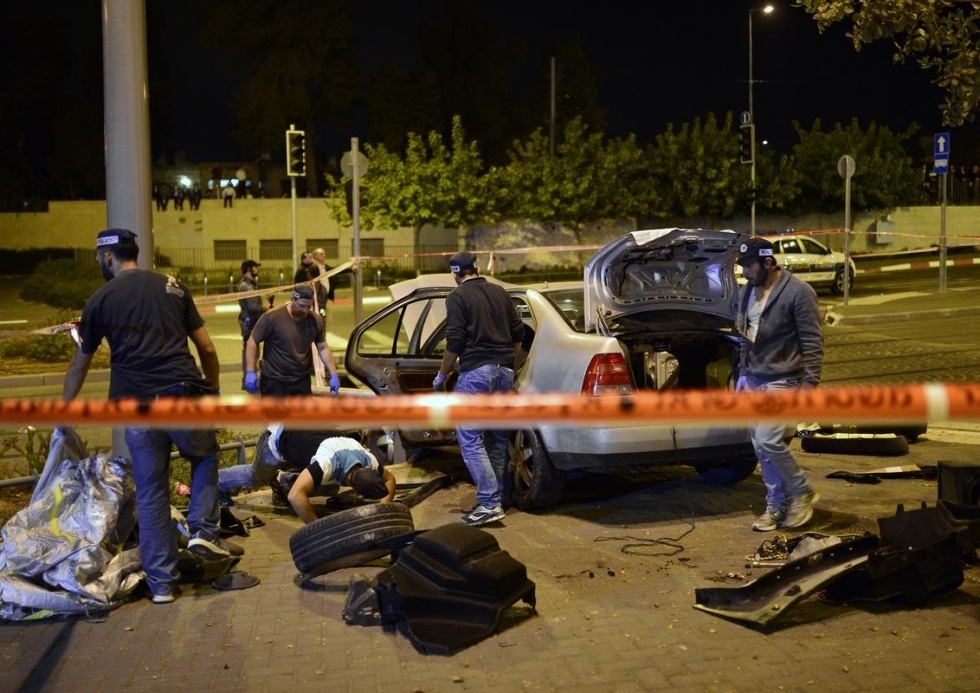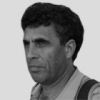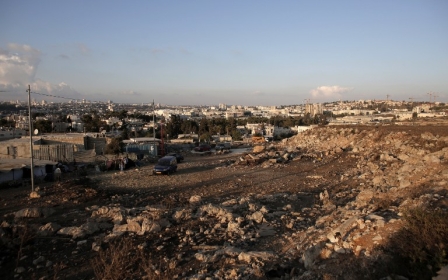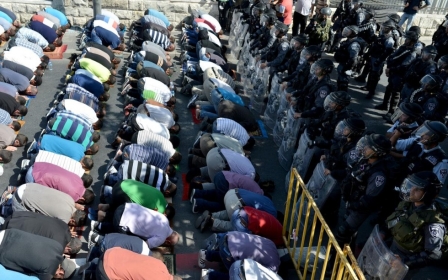Jerusalem on the brink

Ten days before he drove his car on passengers descending from the light train in Jerusalem, killing a three months old baby and wounding four others, Abdel Rahman al-Shaludi, a Jerusalemite Palestinian, published a post on his Facebook page: a picture of Al Aqsa mosque in flames accompanied by the inscription "Al Quds (Jerusalem) in danger, Al Aqsa in danger".
For the Israeli media, this post is a proof that the deadly incident was a premeditated terror attack. It is probably true. At the same time, this post reflects the deep feelings of most Palestinian in Jerusalem: Al Aqsa is under attack and their very existence in the city is under threat. A sure recipe for an upcoming explosion which might shake not only Jerusalem, but also the West Bank and Gaza, if not the whole Middle East.
The current chain of violent events began three months ago, with the murder of the Palestinian teen Muhammad Abu Khdeir, who was burnt alive by three Israelis seeking revenge for the killing of three Israelis teens in the West Bank.
Since then, life in Jerusalem has not known one day of quiet. There have been: violent clashes with police in various Palestinian neighborhoods, harassment of Palestinians in the streets of West Jerusalem, Palestinian youth throwing stones at the light train almost daily, checkpoints at exits from Palestinian quarters, mass arrests of more than 700 Palestinians.
"The worst year since 1967," sums up Fakhri Abu Diab, a Palestinian political activist from Silwan, the neighborhood from which Shaludi came from.
Yet, as always in the last hundred years in Jerusalem, at the heart of conflict between Jews and Palestinians stands Haram a-Sharif or Temple Mount, depends on your allegiance.
Ever since the occupation of East Jerusalem in 1967, there were Jews aspiring for the "removal" or simply blowing up of al-Aqsa mosque and the Dome of the Rock in order to replace them with the Third Temple. But for many years, they acted at the fringes of Israeli society, opposed by most leading rabbis who had claimed that even praying on Temple Mount would be a sacrilege.
This atmosphere has changed in the last few years. The various movements for the rebuilding of the Third Temple have gained ground within the rightwing camp, and the religious vetoes against praying on Temple Mount have started to fall silent. Since the murder of Abu Khdier, these movements have only stepped up their activity, challenging the status quo on the mountain, according to which Jews are prevented from praying there.
These days rightwing Jews pass by the mosques daily, escorted by heavy police guard, sometimes even posing for a symbolic prayer. Every such visit is a source for clashes with the Muslim worshipers on the mountain.
Their political aim is quite clear. "The Temple will rise on the expense of the mosques, there is no doubt about it,'" said Yehuda Etzion, one the movement's leaders, convicted of planning to blow up the Dome of the Rock some thirty years ago. The difference is that this time, people like Etzion enjoy political backing outside their usually limited circles.
Miri Regev, a rightwing Knesset member who heads the committee for Internal Affairs, has conducted 14 sessions on the subject since June 2013. This compares to just four sessions in the previous ten years.
In most of these sessions, the police representatives are scolded for not allowing for more Jews to visit the Temple Mount and for being "too soft" on Palestinian protests.
The discussions have achieved tangible results.
According to Ir Amim, an Israeli organisation for "an equitable and stable Jerusalem" the number of restrictions on Muslim worshipers in al-Aqsa have risen sharply when compared to previous years. During last Ramadan, for example, access to al-Aqsa was forbidden to Muslim men under the age of 50 for five consecutive Fridays.
"These Jews want to prove that the past belong only to them," said 52-year-old Abu Diab who prays regularly in al-Aqsa thanks to his advancing age. "You are not allowed to photograph them, and if you say 'Alla huwe-akbar' [God is great] in front of them, you run the risk of being expelled for two weeks from Al Aqsa by the police".
In September and October, during the last Jewish holidays - from Rosh Hashana (New Year) to Sukkut (Tabernacles) which ended ten days ago - clashes on the hill became a daily event. Palestinian teens threw stones at the Jewish "visitors" while the police shot tear gas and stun grenades into al-Aqsa mosque itself.
It’s during this time of heightened tensions that Shaludi posted about the danger for al-Aqsa.
But the conflict is not just confined to this small patch of Old Jerusalem and troubles from al-Aqsa have spread into the surrounding areas.
In the last few weeks, Jews settlers have moved into dozens of apartments in the Silwan quarter, which sits just a few hundred meters south of al-Aqsa. Their purpose is clear: to enlarge their hold on Silwan and make it into a Jewish neighbourhood.
For Abu Diab, this move is part from a large scale plan: "In order to take over al-Aqsa, you need to take over the areas around it. They do not want to live with us, they want to live instead of us."
Knesset Member Regev does not hide her intention to change the status quo on Temple Mount and insists that she is striving to create justice and unity so that every citizen in Israel - Muslim, Christian or Jew - will be able to pray in his sacred places. “It is unconceivable that there will be freedom of worship for Muslims on Temple Mount, but not for Jews," she has said.
Her model is the Tomb of the Patriarchs (Ibrahimi Mosque) in Hebron, where the army allocates separate days and places for Muslim and Jewish prayers. She insists it “works very well in Hebron" although she is careful not to mention that the mosque was the sight of a massacre in 1994 when a Jewish settler walked into the Ibrahimi mosque and shot dead 29 Muslim worshipers.
The leaders of the movements calling for the rebuilding of the Third Temple do not hide their hopes that once they will be allowed to pray on Temple Mount, they will be able to draw thousands of Jews into the place, leading eventually to the "removal" of the current mosques.
Regev claims that "no one is speaking about the destruction of the mosques" and insists that she is certainly not supporting such a move. However she also stresses that “if there are people calling for it, they should not be prevented from praying on Temple Mount.”
According to Regev, those not happy with freedom for worship on Temple Mount for everyone, including Jews, "are free to look for another country to live in" while anyone holding protests will likely only succeed in cause Temple Mount to be closed altogether.
Regev wrote a law proposition allowing for Jews to pray on Temple Mount. The proposition will be discussed next month, but Regev is realistic. The current government will not allow it to pass, fearing international and above all Jordanian pressure.
But even if a dramatic change in praying arrangements on Haram a-Sharif is not imminent, the threat is there and it is having its effect on Palestinians in Jerusalem. Added to 47 years’ worth of discrimination, house demolitions and worsening living conditions that have been accompanied by growing feelings of mistrust and hatred – all which have been accentuated after Abu Khdeir's murder - Jerusalem is ready to explode.
True, what is happening now does not yet look like an organised Intifada, but riots do not necessarily need a leading hand.
The festering sense of entrapment and what some Palestinians describe as “not having any way out” may prove to be enough to spark a wider escalation. The younger generations learnt to believe that Israel understands only the language of force. As Abu Diab told me: “When you feel you have nothing to lose, the explosion is very near".
The response to yesterday's killing of the three-month-old baby will be probably tougher repressive measures by the Israeli police against Palestinian protesters. By viewing the current situation in Jerusalem, its seems this response only has a slim chance of working.
- Meron Rapoport is an Israeli journalist and writer, winner of the Napoli International Prize for Journalism for a inquiry about the stealing of olive trees from their Palestinian owners. He is ex-head of the News Department in Haaertz, and now an independent journalist.
Photo credit: Forensic teams examine the car driven by Abdel Rahman al-Shaludi (AA)
Middle East Eye propose une couverture et une analyse indépendantes et incomparables du Moyen-Orient, de l’Afrique du Nord et d’autres régions du monde. Pour en savoir plus sur la reprise de ce contenu et les frais qui s’appliquent, veuillez remplir ce formulaire [en anglais]. Pour en savoir plus sur MEE, cliquez ici [en anglais].





